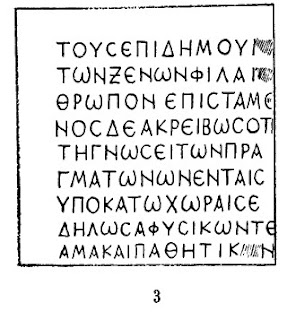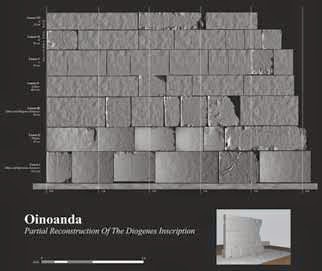Most jigsaw puzzles have pieces that are all roughly the same size but in the case of the myriad fragments of the Great Epicurean Inscription the peculiarities of each piece is one of the guides that researchers have used to work out what philosophical part of the document they belong too (e.g. ethics, physics). The two fundamental clues are the text size and the block size.
A key thing to remember is that the size of the lettering varies. The principal factor that determined it was the level at which the writing appeared on the wall of the stoa: those writings that were displayed at or near eye level were carved in smaller letters than those that were higher up. A second factor, which sometimes came into play, was the degree of emphasis that Diogenes wished to give to certain parts of the inscription: thus titles are carved in extra-large letters, and maxims – both the monolithic Maxims that probably occupied part of the third lowest course of the inscription, above the Physics, and the continuous line of maxims that underscored the whole inscription, running through the spacious margin below the columns of the Ethics – are carved in letters larger than those of the other writings that were displayed at or almost at the same level.
Jurgen Hammerstaedt and Martin Ferguson Smith in their article "DIOGENES OF OINOANDA: THE DISCOVERIES OF 2008 (NF 142–167)" in the journal Epigraphica Anatolica 41 (2008) 1–37 note that "If one disregards the titles, with their exceptionally large letters, one can broadly distinguish three sizes of lettering, which in the descriptions that follow we call “small” (average c. 1.8–1.9 cm.), “medium” (c. 2.3–2.4 cm.), and “large” (c. 2.9–3.0 cm.)".
Also of relevance are the number of columns on each piece and more important the number of lines in each column.
For example the ethical treatise, the physics treatise, Letter to Dionysus and the Letter to Antipater, are all inscribed in letters averaging about 1.7-1.8 cm. They also have 14-line columns.
Meanwhile the treatise on Old Age, is inscribed in letters whose usual height is 2.5-3.1 cm. This treatise, which was carved in 18-line columns, occupied the top three courses of the inscription. The blocks in the topmost course (A) have a height of 31.5–34 cm., five lines, an upper margin 7–9 cm. tall, and no lower margin; those in the second course (B) have a height of 36–39 cm., seven or eight lines, and no margin above or below; and those in the third and lowest course (C) have a height of 45–50 cm., between four and six lines, no margin above, but a lower margin, 21–25 cm. tall, that includes, at the bottom, a scored band 10–14 cm tall.
Then there is the Letter to Mother
And the Letter to a Friend(s) - epistula ad amicos data -
The Will of Diogenes
The Introduction
The Ethical Maxims
The Monolithic Maxims: Probably composed by Diogenes himself, almost certainly stood in the third course from the bottom of the inscription, immediately above the Physics, sharing the course with the Letter to Antipater and Letter to Dionysius. Characteristics of these blocks were: Height 58 cm., Upper margin 8 cm., lower margin 8 cm., left margin 1.8 cm. Letters “medium”. Although the order of the Maxims is not known, it is likely that those concerned with physics preceded those concerned with ethics, this being the orthodox Epicurean order.
Of the ten Maxims that are complete, one occupies nine lines, two occupy ten, and seven occupy
eleven.
Some as yet unclassified text is known as Ten-line-column (TLC) Writings. These are carved on blocks 38–41.5 cm. high and occupied the central course of the inscription, that is to say the fourth from the top and fourth from the bottom, with the three courses carrying Old Age above and the Fourteen-line-column Letters (to Antipater and Dionysius), Maxims, Physics, and Ethics below. Some of the TLC Writings are the work of Diogenes, others are attributed to Epicurus.
While the discussion of positioning of the texts may seem arcane, it is something that is crucial to working out the layout for an eventual mass reconstruction if substantially all of the pieces are eventually recovered.
The thought process is displayed when Martin Ferguson Smith comments with regards to the fragment known as NF 18 that the block is inscribed with largish letters, and, assuming that it belongs to the same writing as HK fr. 3, it will have been about 0.38-0.39 m. high and almost certainly had 10 lines of text and little or no margin above or below. He reasons that a block with these features would have stood high up in the inscription, but not at the very highest level, for, although its lowness and largish letters are indicative of a position high up on the wall of the stoa, there are stones which are less tall (0.335-0.34 m.) and bear larger letters, and a fragment with no upper margin is unlikely to have stood in the topmost course.
He therefore deduces that, almost certainly, NF 18 was in the third course of the inscription, immediately above the course containing the physics treatise. In this connection, it should be remembered that in HK fr. 3, lines 6-7 Diogenes refers to the proofs of physical and ethical matters which he has given 'in the places below'.






